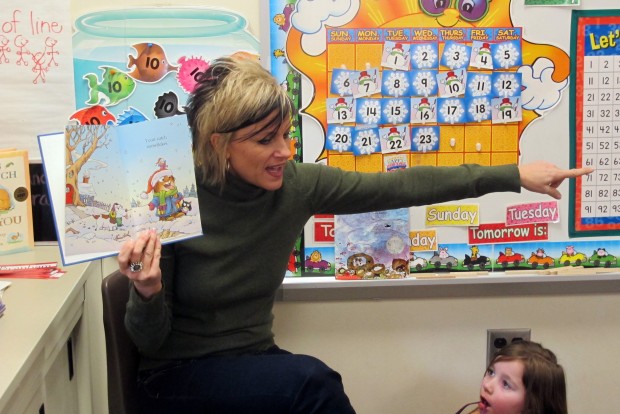As Indiana Starts Transition To Common Core, Teachers Split On New Standards

Elle Moxley / StateImpact Indiana
Lisa Coughanowr, a kindergarten teacher at East Side Elementary in Brazil, reads aloud to her students. She asks questions about the story to check their understanding. Kindergarten and first grade teachers are already using the new Common Core academic standards in their classrooms.
The Common Core is designed to increase the number of students prepared for college and career, but some parents and teachers say the new English language arts and math standards aren’t as strong as what Indiana had before.
“Our kids started coming with a curriculum that we didn’t think was going to make them ‘college ready’ — that’s the term everyone likes to use,” says Indianapolis parent Erin Tuttle. “It’s drastically different than what my older child had, and I found it to be less challenging.”
That’s why Tuttle approached Sen. Scott Schneider, R-Indianapolis, with her concerns about the Common Core. Schneider has proposed legislation to withdraw Indiana from the nationally-crafted academic standards adopted in 46 states.
The new standards are already shaping instruction for Indiana’s youngest students. Some kindergarten and first grade teachers really like the Common Core. But others say they’re a step back from Indiana’s current standards.
- How The Common Core Is Dividing Indiana TeachersStateImpact Indiana’s Elle Moxley visited kindergarten and first grade classrooms already using the Common Core to see how the new standards stack up.Download
Why Some Educators Say ‘It’s Made Us Better Teachers’
Lisa Coughanowr and Hannah Reinoehl teach kindergarten at East Side Elementary in Brazil. They aligned their classrooms to the Common Core last year.
Coughanowr says she still uses many of the same activities she taught under the old state standards. But now story time is peppered with questions that check her students’ comprehension.

Elle Moxley / StateImpact Indiana
Hannah Reinoehl, a kindergarten teacher at East Side Elementary in Brazil, uses sign language to help her students review letter sounds.
“What’s Mom bringing out?” she asks, reading aloud from a book about a snowy day.
The kids spy a steaming mug of cocoa on the page. “Hot chocolate!”
“Remember everything we can learn from the illustrations,” says Coughanowr.
Think of standards like a model skeleton. It’s up to teachers to assemble the bones and flesh them out. One of the kindergarten standards is to demonstrate a command of standard English capitalization and punctuation.
Coughanowr points to a sentence in the book she’s reading aloud.
“Can someone tell me what a sentence always, always starts with?” she asks.
Before, Coughanowr and Reinoehl used themes like transportation or food to help students learn shapes, sounds, numbers and colors. They pulled lessons from a textbook.
“If the standards fit, then that was good, and if they didn’t, we taught the theme,” Reinoehl says.But now the teachers start with the Common Core and design their curriculum around the standards.
“That’s what drives our instruction,” says Coughanowr. “Everything that we plan, we plan around the standards. So maybe there’s not as much fluff as there used to be.”
Indiana had good academic standards before. But proponents of Common Core adoption say teachers weren’t always teaching to Indiana standards. That’s what was happening at East Side Elementary.
Reinoehl and Coughanowr say the new standards have forced them to drill into the topics they teach — and their students have risen to the challenge.
“Looking at the different parts of reading and the different parts of math, how much more they can do with reading, how much better readers they’re becoming, how much better writers they are because we’re more focused on that,” says Reinoehl.
“Yeah, I think you could even go as far to say it’s made us better teachers,” says Coughanowr. “It’s made us understand the learning process a lot better.”
‘It’s A Lot More Regimented’ And Other Concerns With The Core
Schools across the state are implementing the Common Core in kindergarten and first grade. Audrey Fetters teaches at Flint Springs Elementary in Huntington. Like the Brazil teachers, she says the new standards have changed her kindergarten classroom.

Elle Moxley / StateImpact Indiana
Audrey Fetters, a kindergarten teacher at Flint Springs Elementary in Huntington, flips through notes she took during a meeting on Common Core implementation.
“I’m very tied to the Common Core,” says Fetters. “Every decision I make about curriculum is based on the Core, what I need to teach them. We have a curriculum map.”
But Fetters strongly disagrees that the new standards have improved student learning.
“It’s a lot more regimented. There’s not as much teacher choice as there used to be,” she says.
Part of the problem is how the new standards are written. Fetters shuffles through her papers and reads the old Indiana standard for a skill taught in kindergarten, phonemic awareness.
“One, the big idea: What phonemic awareness is,” says Fetters. “Recognize name, capital lower case letters of the alphabet, phonemes — you know, orally stated words — and manipulate and blend sounds to make new words.”
Now Fetters reads the Common Core standards:
Now it’s — you know, let’s see — identify orally upper case, identify orally lower case, identify if words rhyme when given a spoken prompt, state rhyming words in response to an oral prompt, recognize the concept of a syllable, count and state the number of syllables in a word, blend syllables together to form a word when given an oral prompt, segment words into syllables orally when given a prompt, read high-frequency words by sight, blend and rhyme single-syllable words, state the initial sounds in three phoneme words, state the median sounds in three phoneme words, state the final sound in three phoneme words.
Fetters says not only are the new standards confusing, they’re weaker than what Indiana had before.
“It’s pretty complex. If you just look at it, it could almost be overwhelming,” she says.
And it’s a lot for kindergarteners to take in. Fetters used to teach phonemes with arts and crafts, activities she says were developmentally appropriate for kindergarteners. She asked the school curriculum coach if she could still incorporate those lessons into the 90-minute literacy block that’s part of the Common Core.
—Audrey Fetters, teacher
“If I’m blending, having them paint or cut or do this kind of thing, cut paper and make pictures that relate to letter sounds and word patterns? I was told I wouldn’t even get the paint out.”
The state is developing a new assessment based on the Common Core, and Fetters wants her students to do well on it. So she dropped the crafts.
“There’s all this talk of not teaching to the test, but how do you not pay attention to what’s on those tests if my evaluation, if my success as an educator is reflected by how they perform?” she asks.
Fetters says she likes State Superintendent Glenda Ritz’s suggestion — pause, and take a year to review Indiana’s old standards against the Common Core.
Podcast: Play in new window | Download


